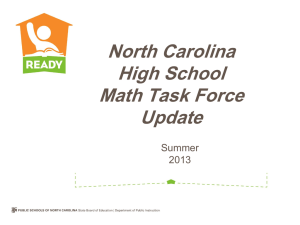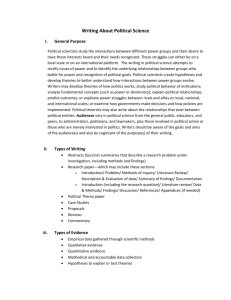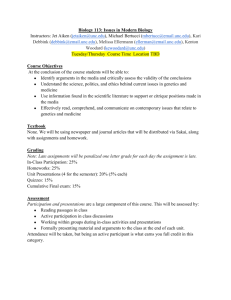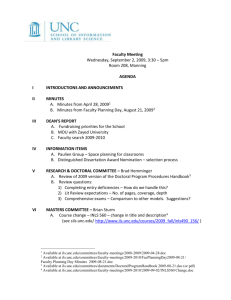here - Carolina Climate Change Scientist
advertisement
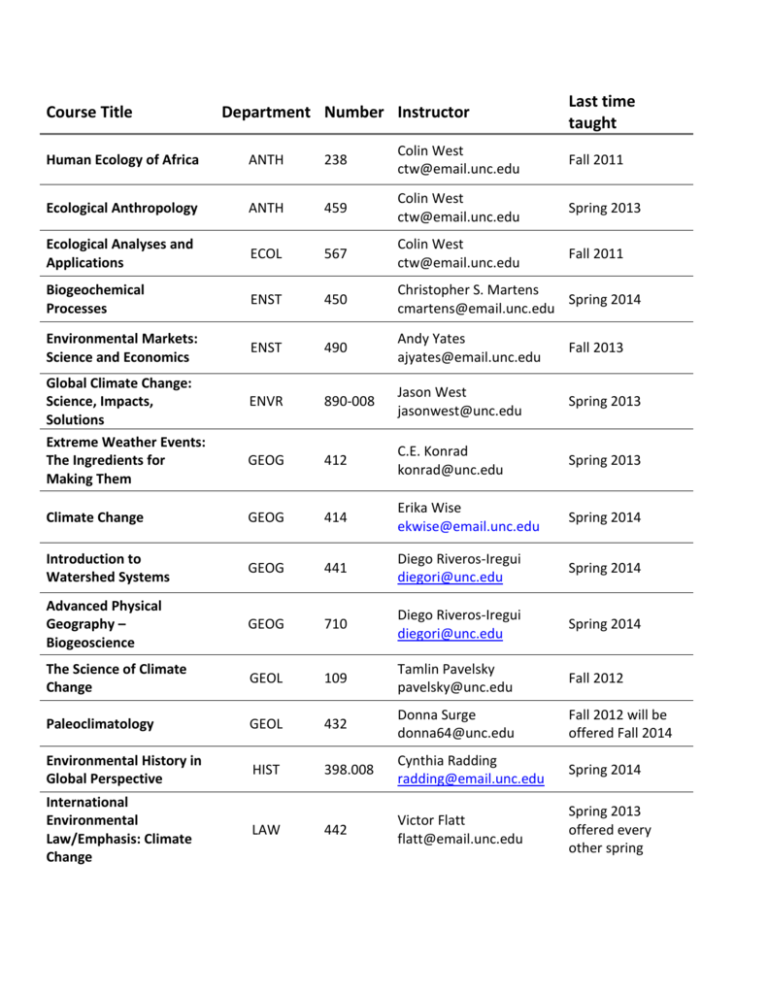
Course Title Department Number Instructor Last time taught Human Ecology of Africa ANTH 238 Colin West ctw@email.unc.edu Fall 2011 Ecological Anthropology ANTH 459 Colin West ctw@email.unc.edu Spring 2013 Ecological Analyses and Applications ECOL 567 Colin West ctw@email.unc.edu Fall 2011 Biogeochemical Processes ENST 450 Christopher S. Martens Spring 2014 cmartens@email.unc.edu Environmental Markets: Science and Economics ENST 490 Andy Yates ajyates@email.unc.edu Fall 2013 ENVR 890-008 Jason West jasonwest@unc.edu Spring 2013 GEOG 412 C.E. Konrad konrad@unc.edu Spring 2013 Climate Change GEOG 414 Erika Wise ekwise@email.unc.edu Spring 2014 Introduction to Watershed Systems GEOG 441 Diego Riveros-Iregui diegori@unc.edu Spring 2014 Advanced Physical Geography – Biogeoscience GEOG 710 Diego Riveros-Iregui diegori@unc.edu Spring 2014 The Science of Climate Change GEOL 109 Tamlin Pavelsky pavelsky@unc.edu Fall 2012 Paleoclimatology GEOL 432 Donna Surge donna64@unc.edu Fall 2012 will be offered Fall 2014 Environmental History in Global Perspective HIST 398.008 Cynthia Radding radding@email.unc.edu Spring 2014 442 Victor Flatt flatt@email.unc.edu Spring 2013 offered every other spring Global Climate Change: Science, Impacts, Solutions Extreme Weather Events: The Ingredients for Making Them International Environmental Law/Emphasis: Climate Change LAW The Practice of Environmental Markets LAW 455 Victor Flatt flatt@email.unc.edu Our Changing Planet: Science, Social Impacts MASC 310 Marc Alperin alperin@email.unc.edu Spring 2013 A Climate of Uncertainty MATH 190 Colin Grudzien cgrudz@email.unc.edu Fall 2013 Climate Modeling Course MATH 578 Chris Jones ckrtj@email.unc.edu Fall 2013 Energy, Transportation and Land Use PLAN 547 Nikhil Kaza nkaza@unc.edu Fall 2014 Planning for Natural Hazards and Climate Change Adaptation PLAN 590 Gavin Smith gpsmith@email.unc.edu Fall 2013 Development Impact Assessment PLAN 745 Todd BenDor bendor@unc.edu Spring 2014 Human Ecology of Africa ANTH 238 Colin West ctw@email.unc.edu Fall 2011 This course focuses broadly on the relationships between ecology and society across Africa. It explores the human ecology of pastoral, agricultural, and hunting-gathering livelihoods through ethnographic case studies. The main goal is to expose students to the rich diversity of human adaptations to environmental conditions in African contexts. A secondary goal is to help students understand how culture, history, and ecology shape these adaptations. Ecological Anthropology ANTH 459 Colin West ctw@email.unc.edu Spring 2013 Ecological anthropology explores the interface between human populations and their ecological surroundings, viewing culture as both something which influences the natural environment and is in turn shaped by it. It investigates how the human/environment relationship varies crossculturally, over time, in different socio-political contexts, and in different ecosystems, and seeks explanations for this diversity. With the current ecological crises and assimilation of many nonWestern cultures, such investigation takes on added urgency and importance. Our main focus will be current theoretical themes in the field of ecological anthropology, including political ecology, disequilibrium, cultural ecology, development anthropology, climate anthropology and complexity. The books chosen represent a sampling of modern ecological anthropology monographs. The readings span a variety of perspectives but include some classic works along with more contemporary pieces. Ecological Analyses and Applications ECOL 567 Colin West ctw@email.unc.edu Fall 2011 This seminar course will provide an introduction to interdisciplinary approaches to the study of ecology, examining ecological concepts from both a natural and social science perspective. “Ecology” is defined broadly to include the study of living organisms at multiple spatial and temporal scales. The course will focus on human-environment interactions and draw heavily from biological, community, and evolutionary ecology as well as landscape, cultural and political ecology. The course is organized around themes and case studies. Each theme explores basic concepts within ecology and then applies that concept to conservation issues from around the world. The main premise of this course is that interdisciplinary knowledge is necessary for understanding complex human-environment relationships. This understanding requires appreciating the complex linkages between ecological and social systems along with the ability to synthesize ideas across disciplines and from disparate perspectives. Environmental Markets: Science and Economics ENST 490 Andy Yates ajyates@email.unc.edu Fall 2013 This course examines the interplay of science and economics in the design of environmental markets. The first part of the course is an introduction to the principles of environmental economics in general and environmental markets in particular. The second part of the course consists of several case studies of environmental markets. These case studies introduce the principles of environmental science and illustrate the critical role that scientific models of natural systems play in the design of environmental markets. The first case study is water pollution (Nitrogen) from wastewater treatment plants into North Carolina's Neuse River. The second case study is local air pollution (N0x, S0x, ozone, PM2.5) from electric power plants in the southeast United States. The third case study is global C02 pollution including special emphasis on carbon sequestration and markets for carbon offsets. The fourth case study is ecosystem service markets including wetland and stream mitigation banking. Biogeochemical Processes ENST 450 Christopher S. Martens Spring 2014 cmartens@email.unc.edu Principles of chemistry, biology, physics and geology are applied to the analysis of the fate and transport of materials in sedimentary, aqueous and atmospheric environments with an emphasis on those elements whose biogeochemical cycles are controlled by microbial processes. The course covers key biogeochemical processes occurring in oceans, lakes, rivers and the atmosphere with a core focus on processes that occur at naturally occurring physical and chemical interfaces. Readings will consist of specific scientific journal articles available on the class Sakai site and through UNC’s E-journal finder found on the UNC Libraries web site. This course is aimed at junior and senior science majors who have completed basic coursework in disciplinary sciences including chemistry, biology, geosciences, physics and mathematics. The course builds on other coursework offered in the CEE curriculum. Formal prerequisites listed in the undergraduate bulletin can be waived with permission of the instructor. Global Climate Change: Science, Impacts, Solutions ENVR 890-008 Jason West jasonwest@unc.edu Spring 2013 Climate change is a difficult, contentious, and important issue. It will perhaps be the defining environmental issue of the 21st century. This course aims to address the whole complexity of climate change as an issue, by bringing together the science, impacts, economics, abatement technologies, and policy solutions into one course. Through this course, we will address several important questions. What is the scientific basis for our understanding of climate change, and in what ways is that scientific basis uncertain? What changes in climate might we expect over the coming centuries? What would be the impacts of these changes in climate for human well-being and the natural world? What are the sources of emissions of greenhouse gases? What technologies exist or might be developed to allow us to slow climate change, and what international policy solutions might be necessary or preferred? Students will be expected to show mastery of relevant concepts drawn from the Earth sciences, chemistry, physics, engineering, economics, and political science, and be able to explain the relevance of these concepts for our present understanding of human-caused climate change and for the viability of different proposed solutions. By the end of this course, students will be able to: Explain and evaluate the evidence for human-caused climate change, in the context of historical climate change, as well as the relevant scientific uncertainties and possible evidence to the contrary. Explain and quantify the impacts of climate change on human well-being and the natural world, and evaluate means by which these impacts can be reduced (adaptation). Explain the human causes of climate change, including the sources of greenhouse gas emissions. Because energy consumption is central to greenhouse gas emissions, students will understand the global energy infrastructure in a historical context and evaluate technological options for reducing emissions. Apply quantitative analysis of concepts relevant for climate change, drawn from chemistry, physics, and economics, through homework problems. Evaluate the successes and failures of past national and international efforts to address climate change, and evaluate prospects for future management of climate change. Evaluate the issue of climate change from the perspective of individual nations. Assess the communication of science and policy for climate change, as a successful or unsuccessful example of how science and policy can and should inform one another. In completing this course, students will improve their abilities to read and understand research papers from several disciplines addressing climate change, and to apply concepts quantitatively. Students will also improve their abilities to communicate through in-class presentations, and to develop and test hypotheses through an individual research paper. Extreme Weather Events: The Ingredients for Making Them GEOG 412 C.E. Konrad konrad@unc.edu Spring 2013 Extreme weather events are investigated with much attention again to the larger scale atmospheric systems (e.g. wave cyclones, squall lines, supercell thunderstorms) that support their development and sustenance. The ingredients and recipes responsible for their production of extreme weather events are explored. The ingredients refer to the suite of physical conditions that are brought together in space-time by the system to produce the extreme weather. The recipes, in turn, describe the different ways in which the ingredients can be brought together in space and time to spawn the extreme weather. In the first two quarters of the course, the processes and atmospheric patterns that produce extreme weather are described along with the conceptual model of weather entities as living systems. These are applied to weather entities that produce extreme cold air outbreaks, ice storms, snowstorms and high winds. The processes and patterns in the cool season extra-tropical atmosphere are described first, followed by an examination of the cyclonic and anti-cyclonic systems that bring together the ingredients for extreme weather. In the third quarter of the course, severe thunderstorms, very heavy rainfall, and tornadoes are examined with a focus on the supporting meso-scale patterns and processes. Particular attention is given to meso-scale convective systems and how larger scale cyclonic systems assemble the ingredients to produce and maintain these entities. In the last quarter of the course, heat waves and drought are examined and tied to larger scale, persistent anticyclonic systems that support their development. Tropical cyclonic systems (i.e. hurricanes) are investigated as well with a focus on the factors that control their strength and movement. Climatologies of each event type are described, specifically when and how frequently they occur. Also, changes in the frequencies of these extreme events are related to global climate change. The first 5 to 10 minutes of class are used to describe what is going on with the weather both locally and nationally. A wide variety of web-based weather products (e.g. weather observations & maps, satellite imagery) are described and used to provide a spatial perspective on how the ingredients come together to produce extreme weather. This wide breath of material in this course is treated in a largely conceptual manner with a minimal amount of time devoted to the underlying mathematics. A diagrammatical-spatial approach will be used in lecture whereby processes and their interactions in the atmosphere will be described using numerous maps and conceptual diagrams. Because of the breath and complexity of the lecture material you will need to spend time outside class learning the nomenclature, coming to grips with concepts, and linking these concepts together to build conceptual models of the atmosphere. Although attendance will not be taken, you are expected to show up for class prepared to discuss to the lecture material. Finally you are expected to observe the weather during the semester and participate in discussions. Climate Change GEOG 414 Erika Wise ekwise@email.unc.edu Spring 2014 The Earth’s climate has become front-page news and is at the forefront of scientific inquiry. This course will provide a “hands on” introduction to climate change science through a combination of lecture and lab activities. The physical principles governing the Earth’s climate system and variability in the system through time will first be covered to provide a solid background in climate science. The course will then delve into the scientific basis of climate change and the current state of knowledge concerning future projections and their implications for society and the environment. Lab activities will include working with a variety of climate data and climate model output, performing basic analyses, and thinking critically about the results. By the end of the semester, students should be able to: Describe how and why the Earth's climate has changed in the past and distinguish natural climate variability from anthropogenic climate change Explain assumptions underlying climate model projections of future climate and uncertainties related to these projections Identify potential impacts of climate change on human, physical, and biological environments Critically assess news reports concerning climate change and its impacts Formulate research questions concerning climate change, identify data and methods that can be used to address those questions, and analyze and interpret a variety of climate data Introduction to Watershed Systems GEOG 441 Diego Riveros-Iregui diegori@unc.edu Spring 2014 Introduction to the hydrologic and geomorphic processes and forms in watersheds as applied to water quality, the biophysical dimensions of water, and interactions and feedbacks between water, climate, landscape morphology, vegetation cover, and soil processes. Course will cover hydrological processes, the structure of drainage networks, nested catchments, and distribution and controls of precipitation, evaporation, runoff, soil moisture, and groundwater flow. Course will include a two-day field trip to a long-term experimental watershed in western North Carolina. Advanced Physical Geography – Biogeoscience GEOG 710 Diego Riveros-Iregui diegori@unc.edu Spring 2014 Examination of the major processes controlling climate-water-ecosystem interactions at the landscape level, and development of a quantitative understanding of the physical and biological processes responsible for landscape pattern and evolution. The course will introduce students to key concepts in terrestrial and aquatic biogeoscience, including the fundamental principles governing fluxes of C, N, sediment and dust, and prediction of how the magnitude and dynamics of these fluxes will be altered under the effects of disturbance (e.g., wildfire, drought, deforestation, land-use change). The course will be taught through a combination of lectures, inclass discussions, and reading and writing assignments, drawing examples from recent peerreviewed literature. The Science of Climate Change GEOL 109 Tamlin Pavelsky pavelsky@unc.edu Fall 2012 Offered every Fall Climate change is among the defining environmental problems of our time, yet public understanding of climate science and policy remains limited. The aim of this course is to provide an introduction to the science of climate change and possible means of addressing it. The first third of the course will focus on the earth’s climate system. In the second third, we will discuss the causes and impacts of climate change in the past, present, and future. In the final third, we will examine policy and political responses to climate change. Paleoclimatology GEOL 432 Donna Surge donna64@unc.edu Fall 2012 will be offered Fall 2014 Course Description: Introduction to mechanisms that drive climate, including the interplay between oceanic and atmospheric circulation and fluctuation in Earth’s orbital parameters. Examination and analysis of past climate records ranging from historical documentation to ecological and geochemical proxies (e.g. tree ring analysis; O and C isotopes of skeletal carbonates and soils). Dating methods used to constrain and correlate climatic periods, utility of computer models to reconstruct past climates and predict future climate change. Emphasis placed on paleoclimatology and paleoecology of the late Quaternary (last ~1 million years). Course Objectives: To provide an understanding of (1) what drives climate; (2) how ancient climates can be reconstructed; and (3) what are the important questions currently being asked in the field of paleoclimatology and their significance to present and future climate change. Structure of Course: The class meets twice a week. Lectures will introduce topics for the majority of the semester. Several meetings during the semester will have part of the time devoted to discussion of journal articles related to various topics in paleoclimatology. Students will be required to hand in a 1-2 page written critique of each paper. Major, overriding concepts (not specific details) from each paper are fair game for exam questions. Environmental History in Global Perspective HIST 398.008 Cynthia Radding radding@email.unc.edu Spring 2014 This seminar in history is designed to provide students with the experience of planning and carrying out their own research projects and to open discussions on a variety of topics that are central to environmental history. Its main geographic focus begins in Latin America and extends to other world regions, including North America and South Asia. Environmental history is an emerging field with strong linkages to geography, ecology, and anthropology as well as to the interdisciplinary field of environmental studies. Environmental history helps us understand changes in the land as well as issues of survival, sustainability, conflict, and cooperation among different peoples, power brokers, and economic sectors in society. We shall explore the ecological and social consequences of drought, the problem of communal resource use and management in different historical settings, and the roots of environmental movements in the U.S. and other world regions. International Environmental Law/Emphasis: Climate Change LAW 442 Victor Flatt flatt@email.unc.edu Spring 2013 This class will survey some basic principles of International Environmental Law, discuss some areas in which it has been important such as water resources, trans-boundary pollution, and resources in general. The class will then focus on the most pressing international environmental problem ever, and the one where there is a current struggle to cooperate internationally – climate change. We will not discuss in depth the issues of radioactive disposal, whaling, or the Antarctic treaties. While much of the doctrinal text will not be assigned, the International Environmental Law casebook is a valuable resource for background information (for your papers) and for future reference. Importantly, this is also a seminar class, wherein you will write a paper that is publishable, and review and discuss other papers. Therefore, some of the class will focus on the rules and ways of writing a law review type article, and on your own choice of international environmental law and/or climate change law topics. Thus, the class is not an exhaustive examination of all international environmental law, but an introduction to it – an introduction that you will use to write your own paper on a selected topic. The class is a three credit hour class, but meets for 2 hours (instead of 2.5). As a seminar class, we are expected by the ABA to use this extra time on out of class conferences. A list of law courses being offered each semester is available at: http://www.law.unc.edu/centers/clear/opportunities/courses/ The Practice of Environmental Markets LAW 455 Victor Flatt flatt@email.unc.edu This class will explore the evolving markets in environmental amenities, particularly using carbon trading as a template. The markets will include nutrient trading, and renewable energy credits and other emerging pollution market devices. We will study how some of these markets work and the legal regulatory environment that surrounds them. Particular attention will be paid to the emerging US systems. A list of law courses being offered each semester is available at: http://www.law.unc.edu/centers/clear/opportunities/courses/ Our Changing Planet: Science, Social Impacts MASC 310 Marc Alperin alperin@email.unc.edu Spring 2013 The course is designed to provide background for understanding the scientific and political issues surrounding the debate over global climate change. Students will be introduced to the complex interactions between the sun, atmosphere, ocean, and biosphere that ultimately control Earth’s climate. After covering natural processes that influence climate, the course will focus on the impact of fossil fuel combustion on the chemical composition of the atmosphere and the Earth’s energy budget. We will examine evidence that man’s activities have already caused global warming and investigate scientist’s ability to predict future climate. We will then discuss the political and social dimensions of global-scale climate change as well as strategies for mitigating negative impacts. Students will be assigned weekly problem sets to foster a quantitative understanding of climate change science (these will contribute 20% to your overall grade). Examples of problems include: numerical models to predict future populations and age distributions in developing and developed countries; radiative transfer laws to predict the equilibrium temperature of the Earth with and without greenhouse gases; critical analysis of thermometer and proxy data; sea level rise due to thermal expansion of seawater; calculations of personal carbon footprints; and quantitative analysis of the impact of ‘green’-energy alternatives to fossil fuel combustion. A Climate of Uncertainty MATH 190 Colin Grudzien cgrudz@email.unc.edu Fall 2013 This course will focus around the following questions: What are the physical mechanisms that drive our climate? How are these processes measured and integrated into model simulations? How does climate impact human life, and vice versa? How do we make informed decisions about climate, and policy which impacts it? The first ten weeks will focus largely around the first three questions, with the final project focusing on the last. You should expect nightly homework throughout the semester. There will be some lecture days, but class time will be largely spent on activity based learning through labs, role plays, group discussion and debates. Climate Modeling Course MATH 578 Chris Jones ckrtj@email.unc.edu Fall 2013 Unsure when next offered This will be an active learning class in which the students will be involved in discussing and exploring the models themselves. It will therefore require a commitment to the class and the occasional drop-in will not be feasible (sorry!) There will be four components: Background material on dynamical systems and stochastic dynamics will be provided through video recordings. These will be available on the web and the expectation is that all students keep up with these recordings. Discussion of material and testing of understanding will happen in class each week. Each week a new model will be introduced in lecture format. Background material on geophysical fluids will also be covered in these lectures. One class time each week will be devoted to team-work aimed at further exploration of the models, and their variants. The focus will be on the formulation of questions, both mathematical and physical, and approaches to answering them. Each participant will be a member of a team and will take on a role in the team, e.g., applied mathematician, computational scientist or climate scientist. Each student will rotate through the different roles over the semester. There will be three weeks during the semester when the course will take a break from classwork and the student teams will focus on more in-depth projects which will be presented when the class resumes. Energy, Transportation and Land Use PLAN 547 Nikhil Kaza nkaza@unc.edu Fall 2014 Recent interest in climate change, in general, as well as large projects like Keystone XL. in particular, has focussed the attention of urban planners on the impacts of land use and transportation planning on energy use. This course seeks to explore the reciprocal connections between all aspects of energy (production/conversion, distribution and use), land use, environment and transportation. Evaluation of Federal, state and local policies on energy conservation, alternative energy sources are emphasised. At the end of the course, the students are expected to have learnt the skills to critically analyse impacts, interdependencies and uncertainties of various energy conservation measures and production technologies on different sectors, organisations and communities Planning for Natural Hazards and Climate Change Adaptation PLAN 590 Gavin Smith Fall 2013 gpsmith@email.unc.edu This course provides a graduate-level introduction to natural hazards risk management planning, including climate change-induced hazards. Specific areas of study include the practice of planning and its application to hazard mitigation and disaster recovery. Emphasis is also placed on the connectivity between planning for natural hazards and disasters and climate change adaptation, emphasizing the principles of sustainability and disaster resilience. While the course is grounded in planning principles and practice, and involves the evaluation of plans, it is not limited to planning students. Rather, the course is intended for students that seek to gain a better understanding of how planning plays an important role in the larger issue of natural hazards risk management, including our ability to adapt to a changing climate and create more sustainable, disaster resilient communities. Course Objectives 1) To identify and explore key planning principles and assess the degree to which they are applied in natural hazards risk management planning through the evaluation of the quality of hazard mitigation and disaster recovery plans at the federal, state, and local level; 2) To gain a sound understanding of natural hazards risk management as understood through the lenses of hazard mitigation and disaster recovery; 3) To explore the relationship between sustainability, disaster resilience, and climate change adaptation; and 4) To identify and assess different types of natural hazards risk management governance frameworks, including how existing policies and programs facilitate or hinder pre- and post- disaster planning and the creation of sustainable, disaster resilient communities that are able to better adapt to changing climactic conditions. This course will meet once per week. Class sessions include lectures (emphasizing applicable cases selected from across the United States and abroad) and discussion, oral presentations, and the review of plans by students. Invited speakers include nationally and internationally recognized scholars and practitioners in the field of natural hazards risk management and climate change adaptation. Development Impact Assessment PLAN 745 Todd BenDor bendor@unc.edu Spring 2014 This course provides intensive instruction in methods for predicting, evaluating, and mitigating potential adverse impacts of land development projects, particularly as they affect urban infrastructure. Its purpose is to develop basic skills in using impact assessment techniques, an ability to apply those techniques to the assessment of impacts from actual development projects, and an ability to report impact assessment analyses, findings, and recommendations in a competent, professional manner, assuming your report is to be read and understood by both professional and nonprofessional audiences. Development impact assessment methods are used in a variety of ways in public and private planning, including evaluation of land use planning alternatives, assessment of private and public development proposals, and marketing of development proposals. By analyzing and discussing various examples of those applications, the course will help develop an appreciation of the strengths and limitations of various impact assessment approaches in specific applications.
